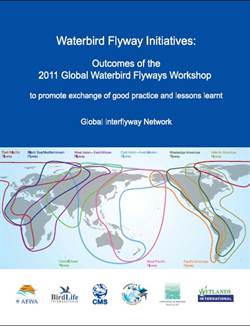
Global Interflyway Network: Korea Workshop 2011
-
Species
The international workshop organised in Seosan City, Republic of Korea, 17-20 October 2011 brought together experts from various flyway initiatives. The meeting provided an ideal opportunity to promote exchange of good practice and lessons learnt from these flyway initiatives which has led to the establishment of the Global Interflyway Network. These proceedings summarize the main outcomes of the meeting and identify priorities for the future.
There are an increasing number of flyway initiatives for migratory bird conservation taking place around the globe, with varied approaches, and with considerable and valuable experience to share. However the experience of these initiatives, while often well publicised within their own flyway is often poorly known elsewhere. This has led to independent evolution of approaches in different flyways and relatively little ‘inter-flyway’ exchange of experience. While many of the challenges faced are similar, different approaches have been taken to tackle them. Much can be gained through the sharing of lessons learned from these different approaches, assessing their strengths and weaknesses, and by taking a more global view of our flyway conservation efforts thus far.
The proceedings from the international workshop organised in Seosan City, Republic of Korea, 17-20 October 2011 summarise the main outcomes of the meeting and identify priorities for flyways for the future.
Suggested citation: Global Interflyway Network. 2012. Waterbird flyway initiatives: outcomes of the 2011 Global Waterbird Flyways Workshop to promote exchange of good practice and lessons learnt. Seosan City, Republic of Korea, 17-20 October 2011. Editors: Chang Yong Choi, Nicola Crockford, Nick Davidson, Vicky Jones, Taej Mundkur, Crawford Prentice & David Stroud. AEWA Technical Series No.40, Bonn, Germany; CMS Technical Series No.25, Bonn, Germany; EAAFP Technical Report No. 1, Incheon, Republic of Korea; Ramsar Technical Report No. 8, Gland, Switzerland. ISBN No. 2-940073-33-3
Conclusions about the value of the workshop and future networking
The Workshop concluded that:
1. Mechanisms, including this workshop, for sharing flyway initiatives’ approaches, experiences and achievements are long overdue, much needed and of great value to inform the wide variety of organizations involved in flyway conservation at multiple levels;
2. Each participant had gained in understanding of, and the applicability of, aspects of other flyway initiatives’ approaches and mechanisms, for potential future enhancement of their own contributions to flyway conservation, often through one specific initiative;
3. There is much common ground in the approaches, challenges and opportunities for implementation across all flyway initiatives discussed, regardless of their geographical location or taxonomic coverage, but each initiative needs to continue to be responsive to the national and regional specificities within its geographical scope for the focus of its attention and approach;
4. The time available for, and the scope of, this first flyway initiatives workshop did not allow for an indepth consideration of the themes addressed, and there would be merit in holding similar workshops in future to further address some of the specific cross-cutting themes considered in this first workshop (such as innovative financing mechanisms), to focus on other migratory taxa beyond waterbirds (such as raptors and landbirds), and to consider other themes not covered in this first workshop; and
5. There is great merit and value in the establishment of an ongoing networking mechanism so as to build on the workshop’s conclusions and to support the implementation of its recommendations, through drawing upon the expertise and experience of flyway conservation practitioners worldwide.
Accordingly the participants at the Workshop agreed to:
1. Establish an open and inclusive network of flyway-scale initiatives, so as to facilitate future networking, sharing of knowledge and approaches, and improving collaboration and synergies between the increasing number of flyway conservation initiatives across the world.
2. Entitle this network the “Global Interflyway Network” (GIN);
3. Promote establishment of electronic information-sharing and dialogue mechanisms to
operationalize the GIN and to meet the communications needs of its partners;
4. Make the capacity of the GIN partnership, resources permitting, available to support and provide input to the work of multilateral environmental agreements (MEAs) addressing flyway issues, including inter alia CMS (and any ongoing work requested of its Flyways Working Group), AEWA and the Ramsar Convention; and to support the future implementation of partnerships and voluntary flyway initiatives; and
5. Encourage other relevant flyway-scale initiatives that were not represented at the October 2011 workshop to participate in the GIN.
Conclusions about the ingredients of successful flyway conservation initiatives
1. Successful conservation of migratory birds – from global to flyway to local levels – depends to a large degree on networks of key individuals with vision, passion, commitment and drive and the networks they create, attracting others with sufficient momentum that subsequent generations of such people have extended and perpetuated the implementation of these networks through more or less formalised frameworks.
2. These frameworks vary substantially in their origins, ranging from intergovernmental to voluntary; there is no single recipe for a successful framework for delivering flyway conservation, as different approaches work for different situations.
3. The main challenge now involves reaching out and gaining the support of stakeholders beyond the core flyway networks of like minded-people, who may be involved in driving the pressures that conservationists seek to reverse.

